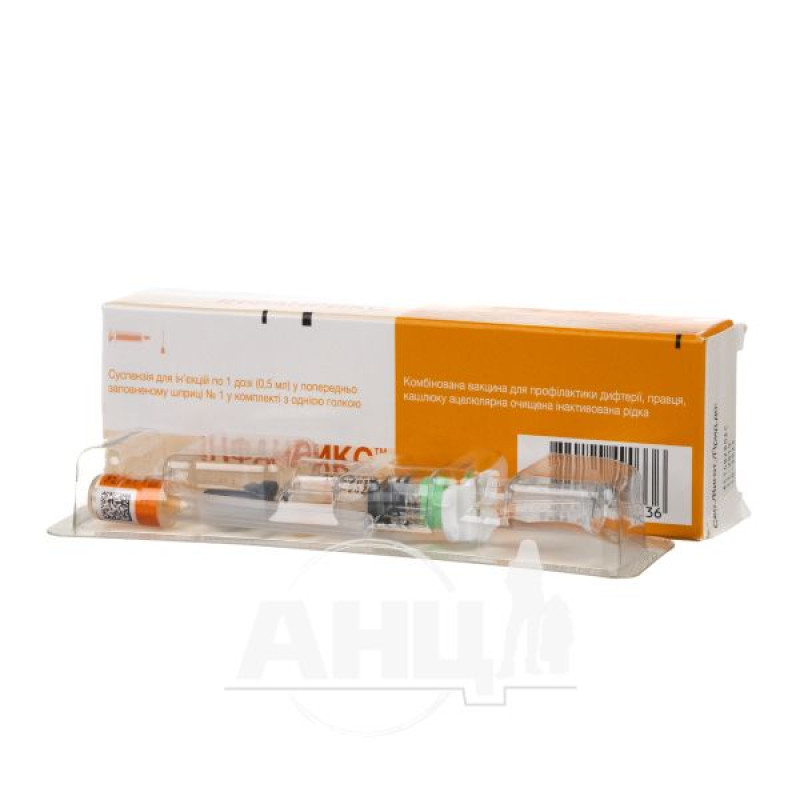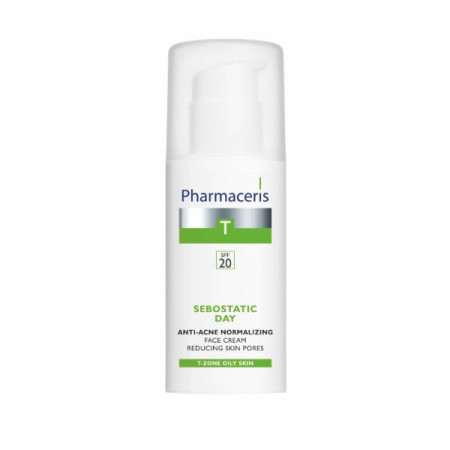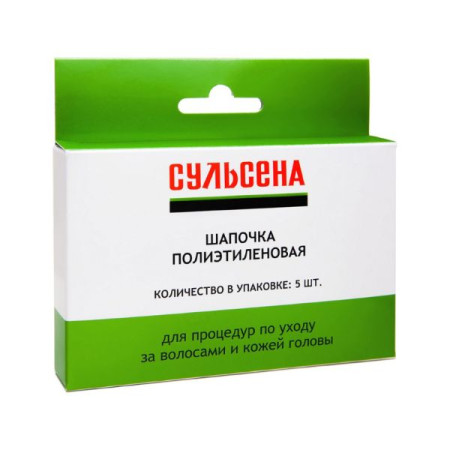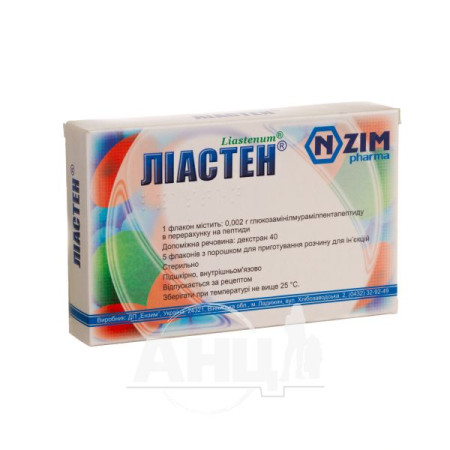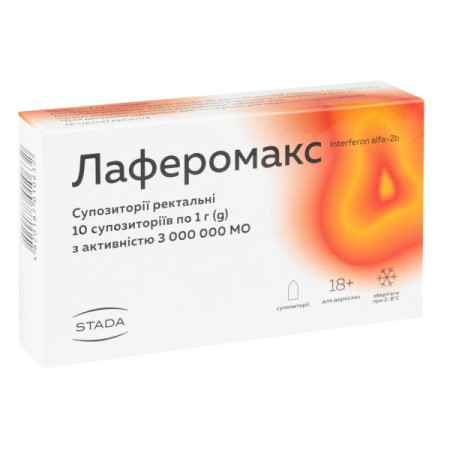Infanrix suspension for injection 1 dose syringe 0.5 ml with needle No. 1
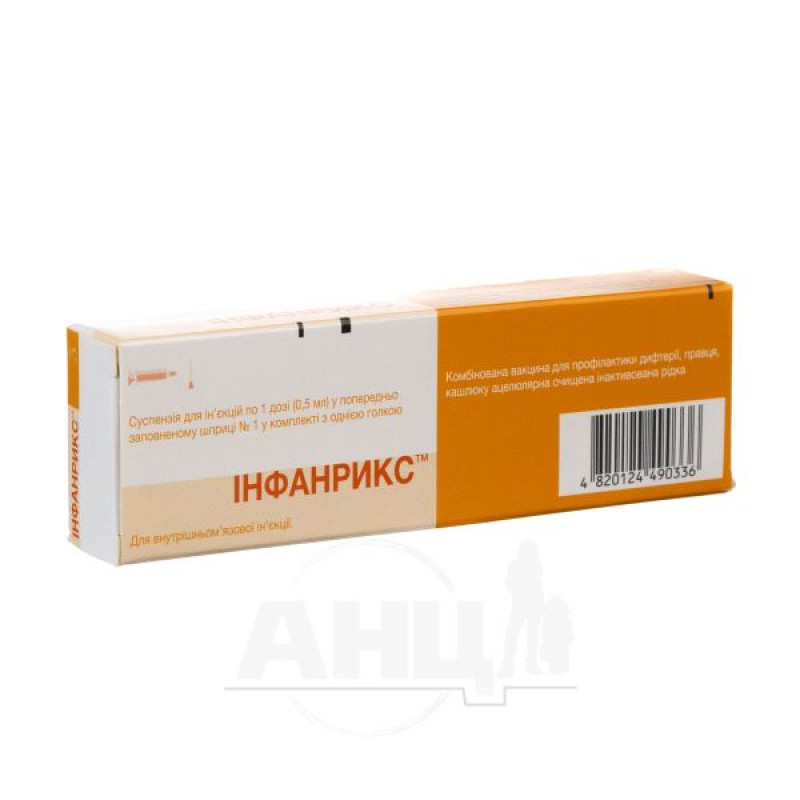
Instructions Infanrix suspension for injection 1 dose syringe 0.5 ml with needle No. 1
Composition
One dose (0.5 ml) contains:
active ingredients:
diphtheria toxoid - at least 30 IU;
tetanus toxoid - at least 40 IU;
detoxified pertussis toxoid (PT) - 25 mcg;
filamentous hemagglutinin (FHA) - 25 μg;
pertactin (PRN) - 8 μg.
Diphtheria and tetanus toxoids, obtained from cultures of Corynebacterium diphtheria and Clostridium tetani, are inactivated and purified. The components of the acellular pertussis vaccine (PT, FHA and pertactin) are prepared by growing a phase I culture of Bordetella pertussis, from which PT, FHA and pertactin are extracted and treated with formaldehyde. Inactivation of PT is irreversible.
Excipients: aluminum hydroxide, sodium chloride and water for injections.
The final vaccine is prepared in saline.
Dosage form
Suspension for injection.
Main physicochemical properties: cloudy liquid, slowly settling to form a white precipitate. Colorless supernatant.
INFANRIX™ is a combined vaccine for the prevention of diphtheria, tetanus, and pertussis, consisting of purified diphtheria and tetanus toxoids, as well as a mixture of three purified antigens of the pertussis pathogen (pertussis toxoid, filamentous hemagglutinin, pertactin), adsorbed on aluminum hydroxide.
INFANRIX™ meets the requirements of the World Health Organization for the production of biological substances, vaccines for the prevention of diphtheria and tetanus. No substances of human origin are used in the production of the vaccine.
Pharmacotherapeutic group
Bacterial vaccines. ATX code. J07AJ52.
Pharmacological properties
Pharmacodynamics
Immune response after primary immunization with INFANRIX™ vaccine
One month after a 3-dose primary vaccination course administered during the first 6 months of life, more than 99% of infants vaccinated with INFANRIX™ had antibody titers greater than 0.1 IU/ml for both diphtheria and tetanus. The vaccine contains pertussis antigens (PT, FHA and pertactin), which play an important role in the formation of specific immunity against pertussis. The immune response to these antigens was greater than 95% in these infants (according to clinical trials).
Immune response after booster vaccination with INFANRIX™ vaccine
After a booster dose of INFANRIX™ in the second year of life (13-24 months), all previously vaccinated infants had antibody titers greater than 0.1 IU/ml for both diphtheria and tetanus. The immune response to pertussis antigens was greater than 96% of these infants.
Pharmacokinetics
Assessment of pharmacokinetic properties is not mandatory for vaccines.
Indication
Active primary immunization against diphtheria, tetanus and pertussis in children from 2 months of age. INFANRIX™ vaccine is also indicated as a booster dose for children who have previously been immunized with a vaccine for the prevention of diphtheria, tetanus and pertussis.
Vaccination of children in Ukraine is carried out in accordance with the requirements of the current orders of the Ministry of Health of Ukraine regarding preventive vaccinations.
Contraindication
INFANRIX™ vaccine should not be administered to individuals with known hypersensitivity to any component of the vaccine or to individuals who have shown signs of hypersensitivity after previous administration of INFANRIX™ vaccine or a vaccine for the prevention of diphtheria, tetanus and pertussis with whole cell components.
INFANRIX™ is contraindicated for vaccination of children who have developed encephalopathy of unknown etiology within 7 days after previous vaccination with a vaccine containing a pertussis component. In this case, the vaccination course should be continued with a vaccine containing diphtheria and tetanus components.
Interaction with other medicinal products and other types of interactions
INFANRIX™ can be administered in any time relationship with other vaccines intended for vaccination of children.
INFANRIX™ can be administered in the same syringe with the vaccine for the prevention of diseases caused by Haemophilus influenzae type b (HIBERIX™). Other injectable vaccines should be administered at separate injection sites.
Patients receiving immunosuppressive therapy or patients with immunodeficiency may not have an adequate immune response to the vaccine.
Application features
According to good clinical practice, vaccinations should be preceded by a review of the patient's medical record (especially regarding previous vaccination and possible adverse events) and a clinical examination.
As with other vaccines, the administration of INFANRIX™ should be postponed in individuals with acute febrile illnesses. However, the presence of a minor infection is not a contraindication to immunization.
If any of the following symptoms are known to have been associated in time with pertussis-containing vaccine, the decision to continue vaccination should be carefully considered. There may be circumstances, such as high pertussis incidence, when the potential benefit outweighs the possible risk, particularly since these events are not associated with long-term complications.
- temperature ≥ 40.5 °C within 48 hours after vaccination, not associated with other identifiable causes;
- collapse or shock-like state (hypotonic-hyporesponsive episode) within 48 hours after vaccination;
- high-pitched crying or screaming lasting ≥ 3 hours is observed within 48 hours after vaccination;
- convulsions with or without fever, occurring within 3 days after vaccination, or without it.
In children with progressive neurological disorders, including infantile spasms, uncontrolled epilepsy, or progressive encephalopathy, it is preferable to postpone pertussis immunization (Pa-acellular pertussis, Pw-whole cell pertussis) until the condition improves or stabilizes. However, the decision to use pertussis vaccine should be made on an individual basis after careful consideration of the potential risks and benefits.
A history of febrile seizures or a family history of seizures is not a contraindication to vaccination.
HIV is not a contraindication for vaccination.
As with all injectable vaccines, appropriate treatment should be available in case of anaphylactic reactions following vaccination. Patients should therefore be observed for at least 30 minutes after vaccination.
As with all vaccines for the prevention of diphtheria, tetanus and pertussis, INFANRIX™ should be administered during the vaccination course with each subsequent dose of the vaccine administered deeply intramuscularly, preferably at a different injection site.
INFANRIX™ vaccine should be administered with caution to individuals with thrombocytopenia or blood clotting disorders, as bleeding may occur when administered intramuscularly to such individuals.
This medicinal product contains less than 1 mmol (23 mg) sodium/dose, i.e. essentially 'sodium-free'.
Under no circumstances should INFANRIX™ vaccine be administered intravenously.
When prescribing primary immunization to premature infants (≤ 28 weeks of gestation), the potential risk of apnoea and the need for respiratory monitoring for 48–72 hours after vaccination should be considered, especially if the infant has a history of respiratory distress syndrome. Since the benefit of vaccination is high in this group of infants, vaccination should not be withheld or delayed.
Fainting (dizziness) may occur during or before any vaccination as a psychogenic response to the needle. It is important to have procedures in place to prevent injury from dizziness.
Use during pregnancy or breastfeeding
Since INFANRIX™ is not intended for use in adults, adequate data on use during pregnancy or lactation in humans and adequate reproductive studies in animals are not available.
Ability to influence reaction speed when driving vehicles or other mechanisms
Does not apply to this group.
Method of administration and doses
The recommended dose of the vaccine is 0.5 ml. The primary vaccination course consists of three doses in the first year of life, followed by a booster dose in the second and sixth years of life.
INFANRIX™ vaccine is intended for deep intramuscular administration.
INFANRIX™ should be administered with caution to individuals with thrombocytopenia or bleeding disorders, as bleeding may occur following intramuscular administration. The injection site should be pressed firmly (without rubbing) for at least two minutes.
Under no circumstances should INFANRIX™ vaccine be administered intravenously.
Instructions for use/application.
INFANRIX™ vaccine is presented as a cloudy white suspension. During storage, a white precipitate and a clear supernatant are observed. Before administration, the vaccine should be shaken well to obtain a homogeneous, cloudy, white suspension and visually inspected for any particulate matter and/or changes in appearance. The vaccine should be discarded if any of the above are observed.
Children
The INFANRIX™ vaccine is used in children from 2 months of age.
Overdose
Post-licensing pharmacovigilance has reported cases of overdose. Adverse events occurring in overdose were not specific and were similar to those observed during routine vaccine administration.
Adverse reactions
Clinical trials
The safety profile below is based on data obtained from immunization of more than 11,400 patients.
As with DTPa and DTPa-containing combination vaccines, an increased incidence of local reactions and fever has been reported following booster vaccination compared with the primary vaccination course. The incidence of adverse reactions per dose of vaccine is defined as follows:
Very common: > 10%.
Common: > 1% and < 10%.
Uncommon: > 0.1% and < 1%.
Rare: > 0.01% and < 0.1%.
Very rare: < 0.01%.
Disorders of the circulatory and lymphatic systems
Very rare: lymphadenopathy1.
Metabolic and nutritional disorders
Common: loss of appetite2.
Mental disorders
Very common: irritability.
Common: restlessness2, high-pitched cry.
Nervous system dysfunction
Very common: drowsiness.
Uncommon: headache1.
Respiratory, thoracic and mediastinal disorders
Gastrointestinal disorders
Common: gastrointestinal disorders such as: diarrhea and vomiting.
Skin and subcutaneous tissue dysfunction
Common: itching.
Uncommon: rash.
Rare: urticaria.
General disorders and injection site reactions:
Very common: redness, local swelling at the injection site (< 50 mm), fever
> 38 °C.
Common: pain2, local swelling at the injection site (> 50 mm)3.
Uncommon: injection site reactions including induration, fatigue1, fever > 39.1°C, diffuse swelling of the injected limb, sometimes extending to the adjacent joint.3
Post-licensing pharmacovigilance
Disorders of the circulatory and lymphatic systems
Thrombocytopenia4.
Immune disorders
Allergic reactions (including anaphylactic and anaphylactoid reactions).
Nervous system dysfunction
Collapse or shock-like state (hypotonic - hyporesponsive episodes), convulsions (with or without fever) within 2 - 3 days after vaccination.
Respiratory system disorders
Apnoea (see section 4.4 for information on apnoea in premature infants (≤ 28 weeks of gestation)).
Skin and subcutaneous tissue disorders
Angioedema.
General disorders and administration site conditions
Swelling of the entire injected limb3.
1 Observed only with booster vaccination.
2 Commonly observed with booster vaccination.
3 Children who have received primary doses of acellular pertussis vaccine are more likely to experience swelling reactions after a booster dose compared with those who have received whole-cell pertussis vaccines. Local swelling (> 50 mm) and diffuse swelling may occur more frequently (very common and common, respectively) if the booster dose is given between 4 and 6 years of age. These reactions resolve on average after 4 days.
4 Observed during vaccination with D and T vaccines.
Expiration date
3 years. The expiration date is indicated on the packaging.
Storage conditions
Store at 2 to 8°C. Do not freeze. Protect from light. Keep out of reach of children.
Incompatibility
INFANRIX™ vaccine should not be mixed with other vaccines in the same syringe, with the exception of HIBERIX™ vaccine.
Packaging
Suspension for injection, 1 dose (0.5 ml) in pre-filled syringes No. 1 complete with one or two needles.
Vacation category
According to the recipe.
Producer
GlaxoSmithKline Biologicals SA, Belgium.
Location of the manufacturer and address of its place of business
Rue de l'Institut, 89 1330 Rixensart, Belgium.
Representative office in Ukraine
LLC "GlaxoSmithKline Pharmaceuticals Ukraine", 02152, Kyiv, Pavla Tychyna Avenue, building 1-B, tel. (044) 585-51-85, fax (044) 585-51-92.
There are no reviews for this product.
There are no reviews for this product, be the first to leave your review.
No questions about this product, be the first and ask your question.






